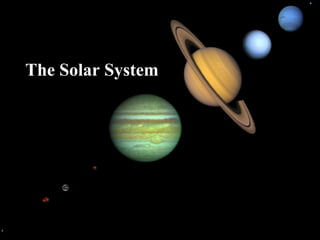
Solar system
- 2. What’s in Our Solar System? • Our Solar System consists of a central star (the Sun), the nine planets orbiting the sun, moons, asteroids, comets, meteors, interplanetary gas, dust, and all the “space” in between them. • The nine planets of the Solar System are named for Greek and Roman Gods and Goddesses.
- 3. Inner and Outer PlanetsInner and Outer Planets • Inner Planets: – Mercury – Venus – Earth – Mars • Outer Planets – Jupiter – Saturn – Uranus – Neptune – Pluto
- 5. The Relative Size of the Planets in the Solar System
- 6. The Sun • The sun’s energy comes from nuclear fusion (where hydrogen is converted to helium) within its core. This energy is released from the sun in the form of heat and light. • Remember: Stars produce light. Planets reflect light. • A star’s temperature determines its “color.” The coldest stars are red. The hottest stars are blue.
- 7. The 9 Planets of the Solar System • Planets are categorized according to composition and size. There are two main categories of planets: – small rocky planets (Mercury, Venus, Earth, Mars, and Pluto) – gas giants (Jupiter, Saturn, Uranus, and Neptune)
- 8. Characteristics of Small Rocky Planets • They are made up mostly of rock and metal. • They are very heavy. • They move slowly in space. • They have no rings and few moons (if any). • They have a diameter of less than 13,000 km.
- 9. Mercury • Mercury has a revolution period of 88 days. Mercury has extreme temperature fluctuations, ranging from 800°F (daytime) to -270°F (nighttime). • Even though it is the closest planet to the sun, Scientists believe there is ICE on Mercury! The ice is protected from the sun’s heat by crater shadows.
- 10. Venus • Venus is the brightest object in the sky after the sun and moon because its atmosphere reflects sunlight so well. People often mistake it for a star. • Its maximum surface temperature may reach 900°F. • Venus has no moons and takes 225 days to complete an orbit.
- 11. Earth • Earth is the only planet known to support living organisms. • Earth’s surface is composed of 71% water. – Water is necessary for life on Earth. – The oceans help maintain Earth’s stable temperatures. • Earth has one moon and an oxygen rich atmosphere.
- 12. Earth’s Moon • It takes the moon approximately 29 days to complete one rotation. The same side of the moon always faces us. • The moon’s surface is covered in dust and rocky debris from meteor impacts. It has no water or atmosphere. • The moon reflects light from the sun onto the earth’s surface.
- 13. • Like Earth, Mars has ice caps at its poles. • Mars has the largest volcano in our solar system: Olympus Mons. Olympus Mons is approximately 15 miles high. • Mars appears red because of iron oxide, or rust, in its soil. • Mars has two moons and takes about two years to complete an orbit. Mars
- 14. Pluto • Pluto has only one moon and takes about 249 years to orbit the sun. • Part of Pluto’s orbit passes inside that of Neptune, so at times Neptune is the planet farthest from the sun. • Pluto was located and named in 1930, but today Pluto is no longer considered a planet.
- 15. Characteristics of Gas Giants • They are made up mostly of gases (primarily hydrogen & helium). • They are very light for their size. • They move quickly in space. • They have rings and many moons. • They have a diameter of less than 48,000 km
- 16. Jupiter • Jupiter is the largest and most massive planet. • It’s diameter is 11 times bigger than that of the Earth’s. • It takes about 12 years for Jupiter to orbit the sun. • Jupiter has 16 known moons.
- 17. Saturn • Saturn is composed almost entirely of hydrogen and helium. • Saturn has many rings made of ice. Saturn’s rings are very wide. They extend outward to about 260,000 miles from the surface but are less than 1 mile thick. • Saturn has 18 known moons, some of which orbit inside the rings! • It takes Saturn about 30 years to orbit the sun.
- 18. Uranus • Uranus is blue in color due to methane gas in its atmosphere. • Uranus has 11 dark rings surrounding it. • Uranus has 21 known moons and takes 84 years to complete one orbit.
- 19. Neptune • Neptune has the fastest winds in the solar system: up to 2,000 km/hr. • Neptune is also blue in color due to methane gas in its atmosphere. • Neptune takes 165 years to orbit the sun and has 8 moons.